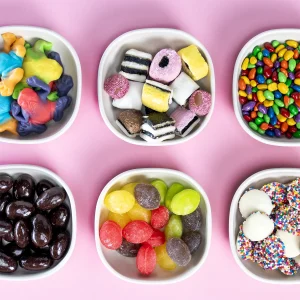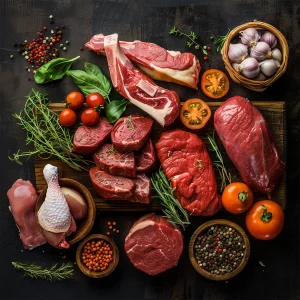Working with Chocolate:
Wilbur or Merckens offers many product options in dark, milk, and white chocolates as well as dark, milk, and white confectionery choic- es. “But isn’t all chocolate the same?” This is the general thought; however, the question cannot be answered with a yes. Real chocolate has to be made with cocoa butter and has to include a certain percentage of choc- olate liquor in its ingredients. Con- fectionery or compound products have a vegetable oil base and may or may not include cocoa butter and/or chocolate liquor in its ingredient statement. Chocolate products usual- ly have a lower melting point than confectionery products, and the melting process and working process needs to be done differently between the two. Also know that each type of product has variations in the grade of the product.
That said, most people use the compound for ease of use, and for that reason we will focus only on that for this pamphlet.
Working With (Vegetable Oil Base) Confec- tionery Products:
Degree of difficulty: low. Most commonly used by in-home users.
Microwave Method
Instructions are based on a 600-watt micro- wave. Since microwaves vary, but inevitably generate extreme heat, you must determine the proper heat setting for your microwave. We recommend using your microwave at 50% until you get the feel for the proper temperature.
Place one pound of wafers in a microwavea- ble container for one minute. Stir product as much as possible. Return to microwave for 15 to 30 second intervals until melted to 115 –120 degrees F. Stir between intervals. Be careful not to overheat.
Cool product to 92–98 degrees F and mold using clean, dry molds. Molds should be at room temperature, not colder than 70 de- grees F. Stir several times whenever you are melting or cooling product so that your tem- peratures are accurate and to prevent streaky results.
Double Boiler Method
Place one pound of wafers in a double boiler over hot, not boiling, water. Stir until melted. Keep water away from product. Keep the water at a temperature between 130–150 degrees F. Water at that temperature will be hot enough to melt the coating but not hot enough to burn your hand if touched. Melt product slowly to 115-120 degrees F. Stir product frequently. Prevent all moisture (steam vapor) from contacting product.
Cool product to 92–98 degrees F and mold using clean, dry molds. Molds should be at room temperature, not cold- er than 70 degrees F. Stir several times whenever you are melting or cooling product so that your temperatures are ac- curate and to prevent streaky results. (Hint: Heating at too high of heat or the addition of any water will destroy the coating.) If coating is too thick after melt- ing process, do not increase temperature or add water. Simply add a small amount of lecithin to thin to the proper consisten- cy. Another method to thin is to add para- mount crystals; but do not exceed a 5% level. Remember never to heat or cool product without stirring.
How to Mold With Coating Wafers
Cool melted coating to 92–98 degrees F.
The molds should be at room tempera-
ture and free from moisture. Pour melted coating into molds. Tap molds on table several times to remove air bubbles. After depositing, place molds in a cooling tun- nel at 45–55 degrees F or in a refrigerator until set. Mold will release when turned over and tapped. If not, return to cooling
tunnel or refrigerator for a few more minutes. Remember, larger molds will take longer.
How to Paint, Decorate, and add Flavors
Using a paint brush and painting directly into the mold, choose the wafer color of your choice. Let each color dry before add- ing a new color so they do not run together. Let dry completely, then fill mold with coating.
When decorating, place coating in a pastry bag or plastic squeeze bottle with a fine tip. If coating gets too thick, reheat in a water bath or microwave. To clean, let dry and scrape out of bottle or bag. You can re-melt and use again. Only oil-based flavorings can be used with coating wafers. A water-base flavor will cause coating to thicken and create lumps.
The Chocolate Has Cooled Too Much
Add some warm chocolate or gently warm the bowl until the chocolate reaches correct working temperature. This will not work for chocolate that has become pudding-like.
Streaks Appear in Finished Products
A “fat bloom” appears as a visible white dull film on the surface to cause severe whiten- ing of the surface, with soft or crumbling tex- tures on the interior. The working temperature is slightly too warm. Add some coating comes into contact with the chocolate, it will cause it to thicken, rendering it useless for chocolate work. It can be used for cooking and fillings.


 Instant Beef Broth Mix
Instant Beef Broth Mix  Assorted Jawbreakers
Assorted Jawbreakers  Chicken Breasts,Frozen,Pastured,Local, ABF,Non-GMO
Chicken Breasts,Frozen,Pastured,Local, ABF,Non-GMO